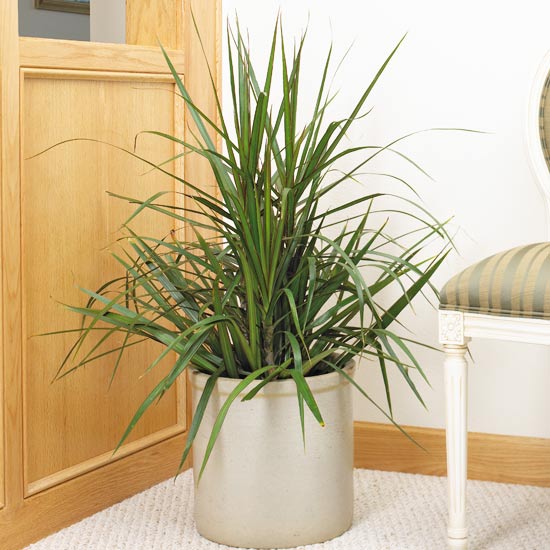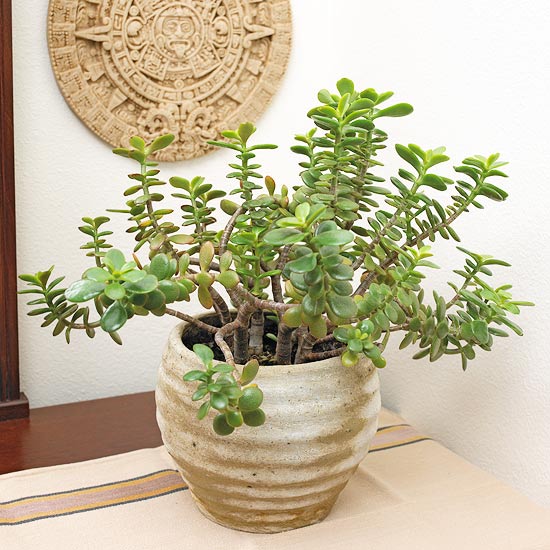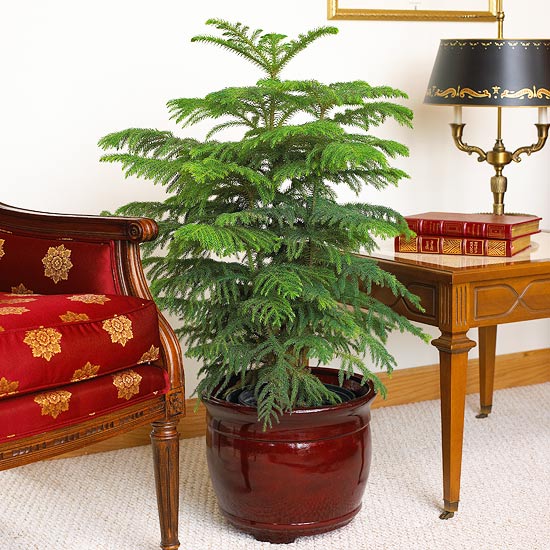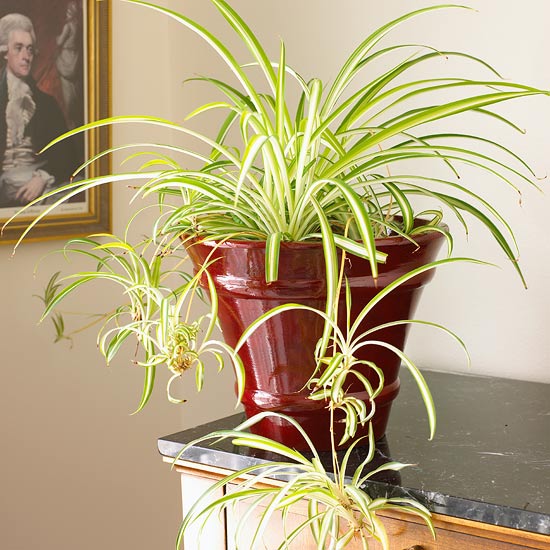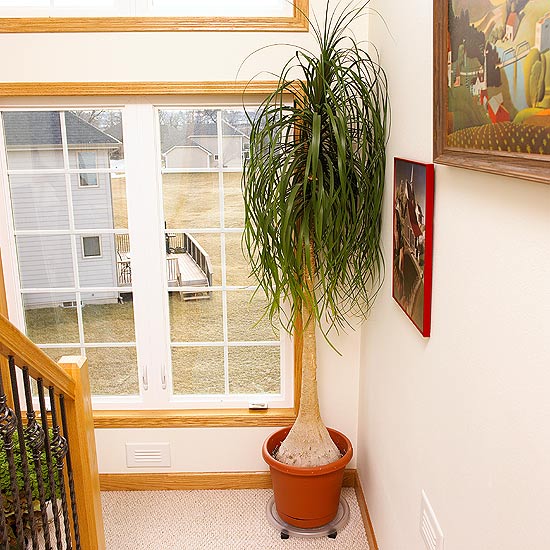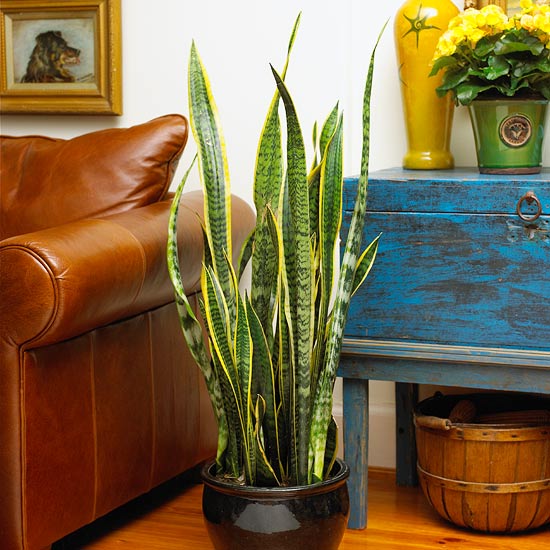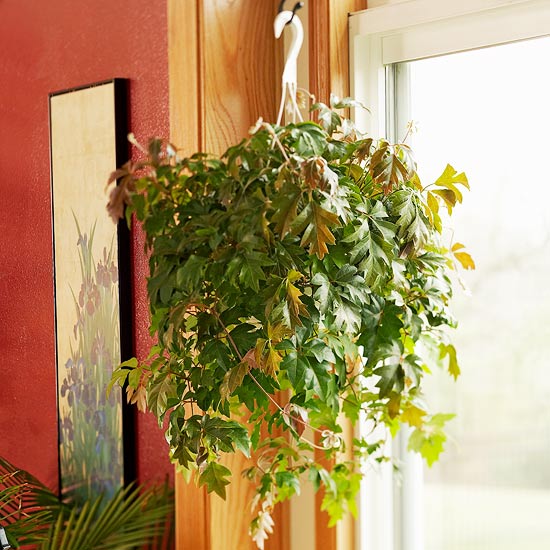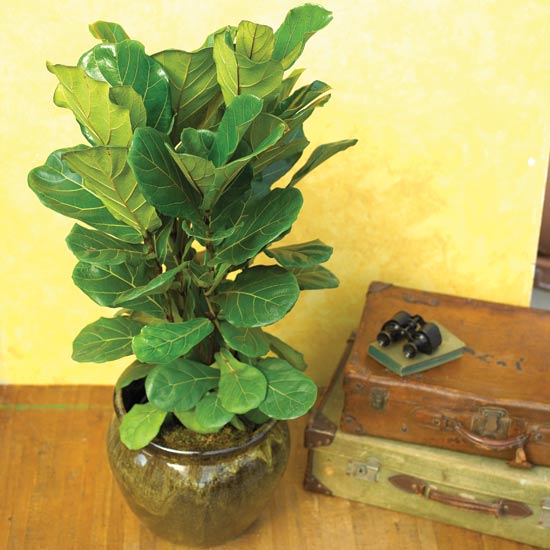Peperomia
Peperomias are a diverse group of small houseplants with waxy and often highly textured leaves. Red-edge peperomia (pictured) has a narrow band of red surrounding a wide creamy leaf margin. Other peperomias we love include ripple peperomia, watermelon peperomia, baby rubber plant, and silverleaf peperomia.
Why We Love It: Its waxy, colorful foliage adds a splash of color in any room — without taking up a lot of space.
Name: Peperomia spp.
Growing Conditions: Low to medium light; 60-75 degrees F.; allow the soil surface to dry between waterings
Size: To 1 foot tall and wide
Note: This plant is poisonous if eaten or chewed on by dogs or cats.
Dracaena
This plant is as impressive as its name. It bears tufts of long, narrow, deep green leaves edged in red at the tips of woody gray stems. Young plants are shrubbier, but soon grow more upright. The variety ‘Tricolor’ has pink-and-cream leaf margins, and is sometimes known as rainbow plant.
Why We Love It: Its grassy leaves on tall stems give it a festive appearance.
Name: Dracaena marginata
Growing Conditions: Medium to bright light; 65-75 degrees F.; allow the soil surface to dry between waterings
Size: To 10 feet tall and 2 feet wide
Note: This tree is poisonous if eaten or chewed on by dogs.
Jade Plant
If watering is an issue, jade plant may be for you. This slow grower can survive for decades if it has bright light and stays dry. It combines well with cacti and other succulents. It appreciates normal room temperatures during the growing season, but grows best if you keep it on the cool side and just moist enough to prevent leaves from shriveling through winter.
Why We Love It: It’s a low-water, treelike plant with interesting, gnarly branches and succulent, fleshy leaves.
Name: Crassula ovata
Growing Conditions: Bright light; 65-75 degrees F., 55 degrees F. in winter; keep moderately dry
Size: To 6 feet tall and 3 feet tall
Norfolk Island Pine
The secret to keeping Norfolk Island pine healthy is to give it ample light and humidity. In low light, the lower branches may turn brown and fall off. If the air is too dry, it becomes a prime target for spider mites, a common houseplant pest. In its native habitat, Norfolk Island pine can reach 200 feet tall, but don’t worry — indoors, it seldom grows taller than 10 feet.
Why We Love It: This tree is perfect fordecorating for Christmas — or giving as a holiday gift. Outside the holidays, its soft texture adds a cozy feeling to any room.
Name: Araucaria heterophylla
Growing Conditions: Bright light; 60-75 degrees F.; allow the soil surface to dry between waterings
Size: To 10 feet tall and 5 feet wide
Spider Plant
You may remember this from your grandmother’s house; spider plants have been grown for years and are still popular today. Look for a number of varieties — from types with plain green leaves to others that offer foliage marked with cream or white stripes. All make handsome hanging plants that develop plantlets at the ends of arching stems. These babies readily root in water or potting soil to start new plants.
Why We Love It: It offers tons of old-fashioned appeal and an easy-care nature.
Name: Chlorophytum comosum ‘Vittatum’
Growing Conditions: Medium to bright light; 60-75 degrees F.; keep the soil evenly moist
Size: To 1 foot tall and 2 feet wide
Ponytail Palm
Despite its common name, this plant is a succulent rather than a true palm. Its graceful arching leaves are always attractive and its swollen trunk looks great, too. (The trunk holds moisture for the plant.) Keep your ponytail palm in a container only a couple of inches wider than its trunk base to control its size. It is sometimes sold as Nolina recurvata.
Why We Love It: Because the trunk actually stores moisture, ponytail palm can survive for long periods without watering.
Name: Beaucarnea recurvata
Growing Conditions: Bright light; 65-75 degrees F., 50-55 degrees F. in winter; allow the soil to dry between waterings
Size: To 10 feet tall and 4 feet wide
Snake Plant
This carefree succulent plant tolerates neglect extremely well. If you’ve had no success with houseplants other than plastic ones, give snake plant a try. In addition to the tall form pictured here, shorter, bird’s-nest forms are available. All types withstand low light but appreciate brighter conditions. The only problem likely to develop is root rot if you overwater the plant.
Why We Love It: It’s nearly indestructible and has architectural, sword-shaped leaves
Name: Sansevieria trifasciata ‘Laurentii’
Growing Conditions: Low to bright light; 60-85 degrees F.; allow the soil surface to dry between waterings
Size: To 4 feet tall and wide
Grape Ivy
‘Ellen Danica’, the variety of grape ivy pictured here is often called oakleaf ivy because its leaves are more deeply cut than other types of grape ivy. Regardless of the variety, grape ivy is a vine with tendrils that readily cling to a trellis or stake. It offers shiny, deep green leaves that create a very nice texture.
Why We Love It: Even though it’s a vine, grape ivy has more of a mounding habit — so it’s a perfect choice for lush, tidy-looking hanging baskets.
Name: Cissus rhombifolia
Growing Conditions: Medium light; 65-80 degrees F.; keep evenly moist
Size: To 6 feet as a vine
Chinese Evergreen
This plant has great foliage; the leaves are punctuated with shades of silver, gray, or shades of green making Chinese evergreen an attractive choice to brighten low-light areas of your home. Take a cue from shopping mall plantings and use Chinese evergreen as a ground cover around an upright, treelike houseplant. Or showcase it alone as a specimen plant.
Why We Love It: It’s extra tough and has attractive leaves that brighten low light spots.
Name: Aglaonema commutatum
Growing Conditions: Low to medium light; 60-75 degrees F.; keep evenly moist
Size: To 3 feet tall and wide
Note: All parts of this plant are poisonous and can cause severe irritation of the lips, tongue, and throat if eaten or chewed by pets or children.
Fiddleleaf Fig
Fiddleleaf fig is a beautiful tree that gets its common name comes from the violin-shape outline of its leathery, deep green leaves. It tolerates low light well, though it may lose its lower leaves in dim spots. If your fiddleleaf fig grows too tall, prune stems back to the desired height, or start a new plant by air layering elongated shoots.
Why We Love It: This is one of the classiest-looking indoor trees thanks to its big leaves and the shape it forms as it grows.
Name: Ficus lyrata
Growing Conditions: Medium to bright light; 65-75 degrees F.; allow the soil surface to dry between waterings
Size: To 15 feet tall and 5 feet wide
Source from bhg.com


